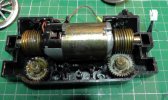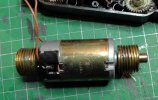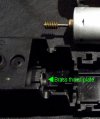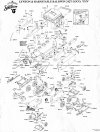maxi-model
UK/US/ROW steam narrow gauge railways 1:1
Looks like it has had a transplant already then. I still stand by what I said, usual belt and braces job with an old electric motor - clean the commutator and check and clean the motor brushes and springs. If you can get them replace the magnets - the people who offered re-gaussing services might be long gone. Economically, time for another transplant ? One of the first locos I had was one of these. Very simple construction with cast metal weights in the side tanks. The dummy valvegear was a bit wobbly with wear. It could haul my 3 full length GRS L&B coaches, so no lack of adhesion or grunt. Max





